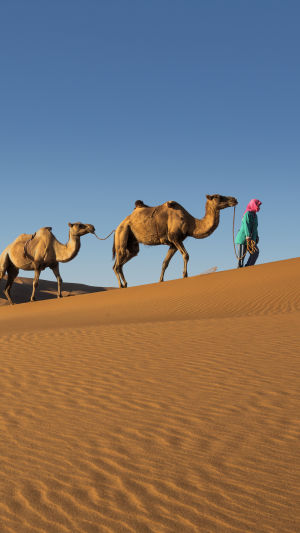The desert is like an ocean, and the camel is the boat that everyone needs in the sea. Desert areas are hot and dry, camels are drought tolerant and docile, which is very important for people living in desert areas.
Camels are animals that live in deserts and semi-deserts. In the long-term evolution process, its organ functions and living habits have formed many characteristics. The purpose is to adapt to the unique desert conditions, so it is known as the "desert boat".
Camels have great hunger and thirst tolerance, and they can still walk physically without eating water plants for 21 days. Camels are very resistant to hunger and thirst. Every time they drink enough water, they can go without water for many days and still be able to move in hot, arid desert areas. Camel blood has a strong water storage capacity and has the characteristics of resistance to wind and sand, so camels can coexist harmoniously with desert grasslands.
The camel's ears have fur, which makes it able to block the wind and sand from entering the ear, and the camel has double eyelids and thick long eyelashes, which can prevent the wind and sand from entering the eyes, and the camel's nose can be freely closed, which makes the camel not afraid of the wind and sand at all.
The sand is soft, and it is easy for human feet to fall into it, while the camel's feet are flat, and there are thick and soft meat pads under the feet. The camel is familiar with the climate in the desert, and when a strong wind is about to hit, it will kneel, and the person traveling on the camel can prepare in advance.
People's understanding of camels may be limited to knowing that they are an important means of transportation in the desert. In fact, camels have many interesting characteristics. Let's take a look at them together.
1. Camel has excellent digestive function
Camels are never picky about their food. Even if they encounter bitter salt water in the Gobi desert, they don't mind drinking them all.
Every time before a trip, the camel owner feeds it some salt, so that it can drink more water and store it in its body, thereby increasing its ability to withstand thirst.
2. Camels can store fat
The most special symbol of a camel is its hump. People think that the hump stores water. In fact, the camel's hump is used to store fat. At most, it can hold 50 kilograms of fat, accounting for about 1/5 of its body weight. When the camel feels thirsty, it turns the fat on the hump into metabolic water.
3. Camels can store water
A camel's stomach and muscles can store a certain amount of water, and its stomach can store nearly 100 kilograms of water at a time. Therefore, it can use stored fat and water to sustain life when food and water cannot be found for a while.
4. Camels generally don’t sweat
Although camels have strong hair and live in a very hot environment, camels only sweat a little when the temperature reaches 40°C. Therefore, the water in its blood is kept well, it is not easy to be dehydrated, and the blood circulation is good.
5. The villi keep the body temperature constant
The camel's body has fine and soft down, which can resist the sun's exposure. No matter how high the temperature is, the temperature under the coat will not exceed 40 ℃.
In addition, camels have fat humps, which help camels regulate their body temperature and keep them warm in winter and in summer.
6. Camels consume very little water
Under normal circumstances, the camel does not breathe frequently. Even in the hottest weather, it only breathes 16 times per minute, and when it is cool, it only breathes 8 times, so that it does not consume too much water.
Because there are many very thin and tortuous pipes in its nose, the pipes are usually filled with moist liquid, and the water will be recycled and used in the body repeatedly.
Camels are very important to people living in desert areas because of their ability to survive in arid and harsh environments and their special ability to walk long distances in the desert.





